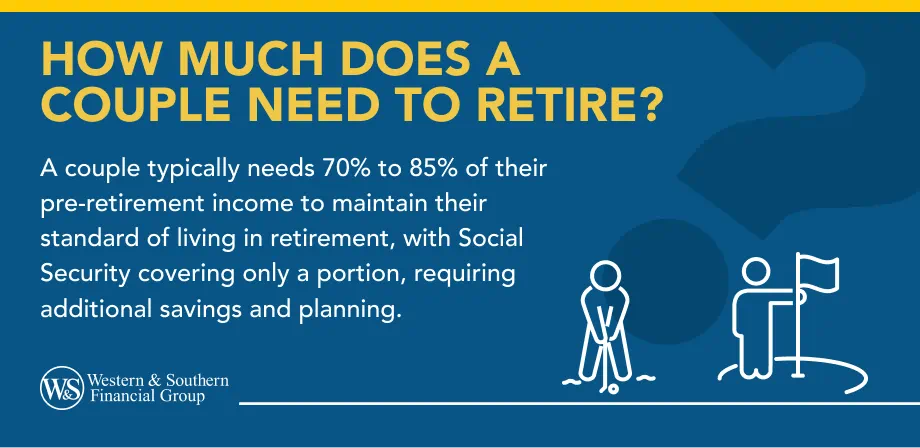

Key Takeaways
- Most couples will need about 70% to 85% of their pre-retirement income to maintain their lifestyle in retirement.
- Social Security replaces only about 40% of a typical worker’s income, so most households will need additional income sources.
- Married couples often have higher combined retirement income, including access to spousal Social Security benefits that may increase total payouts.
- Many retirees rely heavily on Social Security, with some receiving at least half - or even most - of their income from the program.
- Planning ahead, including using retirement calculators or working with a financial professional, can help couples understand how much they may need to save.
Retirement planning can feel overwhelming, especially as fewer employers offer pensions. Couples may wonder how much they’ll need together, but the answer depends on each partner’s needs and circumstances, though planning as a team can offer advantages. There’s no single approach, but aligning your goals and expectations can help you build a retirement strategy that works for both of you.
How Much Do Couples Need?
Back to the original question: Just how much does a couple need to retire? In general, you will need roughly 70% to 85% of your pre-retirement income to continue your standard of living in retirement.1
As a couple, the good news is that, along with having to plan for the expenses of two people, you can plan on having two people's income and savings. This can help bolster your spending (and saving) power.
Social Security Has Limits
Social Security replaces about 40% of a median wage earner's income in retirement, which means many people may still need additional income sources.1 Benefits are available to anyone who has worked at least ten years and earned 40 work credits. Being married does not reduce your benefits. In some cases, it can even increase what one spouse receives if their earnings are much lower.
Average Monthly Social Security Benefits
Spousal benefits allow a lower-earning spouse to collect up to 50% of the higher-earning spouse’s benefit. They’ll receive whichever amount is higher —the benefit based on their own work record or the spousal benefit. If the higher-earning spouse dies, the surviving spouse may receive up to the full amount the deceased spouse was collecting.
Figures Increase for Married Couples
Being part of a couple can come with some unexpected financial advantages. For example, the average retirement income for a couple is often more than double that of a single person, even when comparing two individual incomes to one shared household.
Income Snapshot for Married Couples (Age 65+, 2024)3
- Average household income: $126,500
- Median household income: $91,410
Median income is often seen as a more representative measure because average income can be pulled upward by a small number of very high-earning households.4
Income Snapshot for Single Adults (Age 65+, 2024)3
| Group | Median Income | Average Income |
|---|---|---|
| Women living alone | $29,460 | $43,800 |
| Men living alone | $35,750 | $54,090 |
When comparing these numbers, a married couple’s median income is significantly higher than the combined median income of single men and women in the same age group. Together, single adults have a median income of $65,210, which is about $26,200 less than the median income of a married-couple household.
The Role of Social Security
Social Security can be a major source of income in retirement, but it was never designed to cover everything. Among elderly beneficiaries:2
- 39% of men and 44% of women receive 50% or more of their income from Social Security.
- 12% of men and 15% of women rely on Social Security for at least 90% of their income.
Plan Ahead
Half of workers (54%) report they and/or their spouse have tried to calculate how much money they will need to have saved so that they can live comfortably in retirement.5
Generally, getting ready for retirement requires planning ahead and saving up your money many years in advance. You may want to consult a financial professional to determine any adjustments that may benefit your retirement plans.
In addition, there are several tools you can use to estimate how much you may need for retirement. For example, a retirement calculator can help walk you through the considerations as you plan your retirement, including your investments, inflation and how much of your income you hope to replace.
Create a retirement strategy that supports both you and your spouse’s future needs. Start Your Free Plan
Frequently Asked Questions
What are the average retirement savings by age?
How much do you need to retire at 60?
How much do you need to retire at 50?
Sources
- How much of my income will Social Security replace? https://www.dol.gov/agencies/ebsa/workers-and-families/preparing-for-retirement.
- Social Security Fact Sheet. https://www.ssa.gov/news/press/factsheets/basicfact-alt.pdf.
- HINC-02. Age of Householder-Households, by Total Money Income, Type of Household, Race and Hispanic Origin of Householder. https://www.census.gov/data/tables/time-series/demo/income-poverty/cps-hinc/hinc-02.html.
- Household Income: What It Is and How to Calculate It. https://www.investopedia.com/terms/h/household_income.asp.
- 2025 RCS Fact Sheet #3 Preparing for Retirement in America. https://www.ebri.org/docs/default-source/rcs/2025-rcs/rcs_25-fs-3_prep.pdf?sfvrsn=f6e3042f_2.







